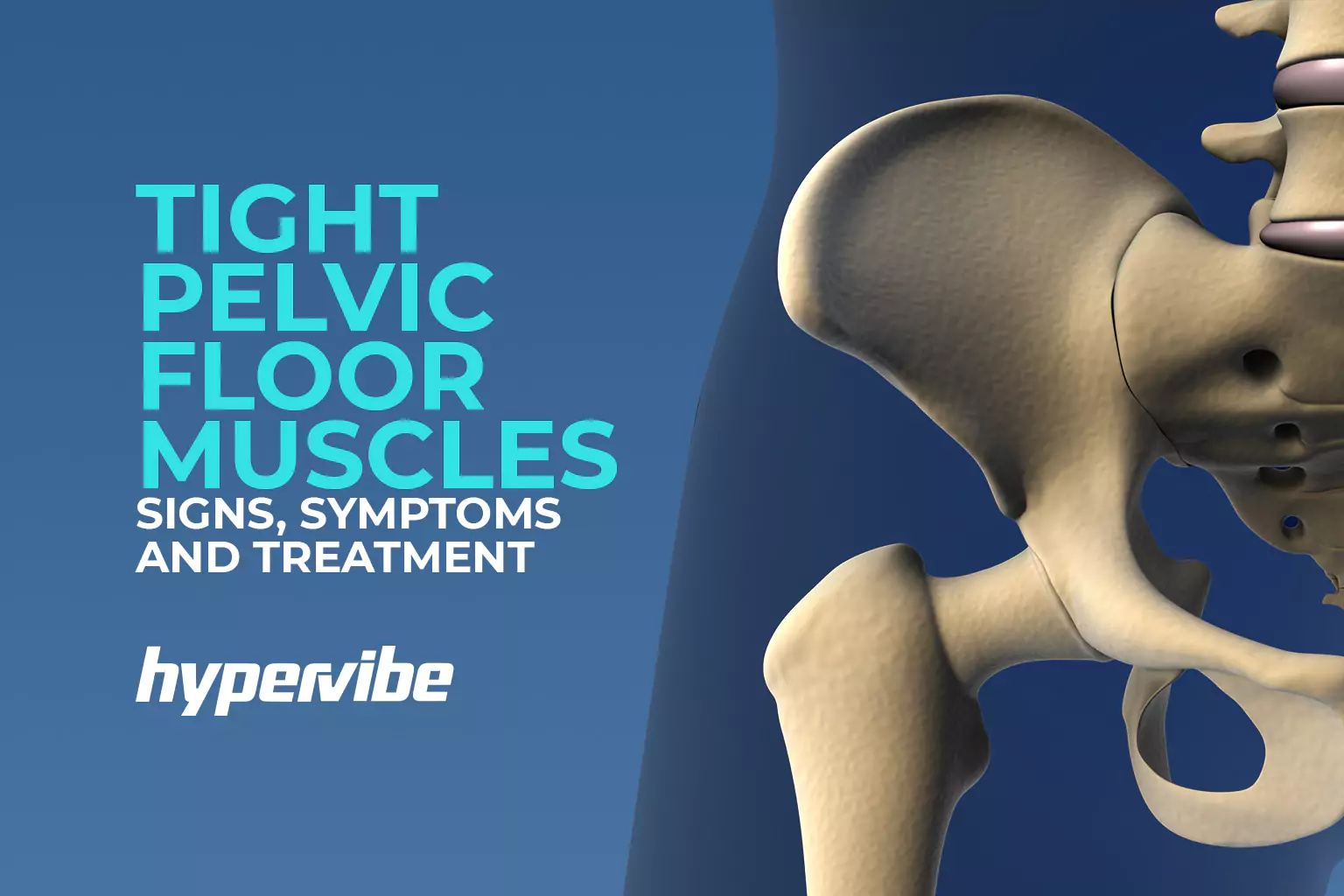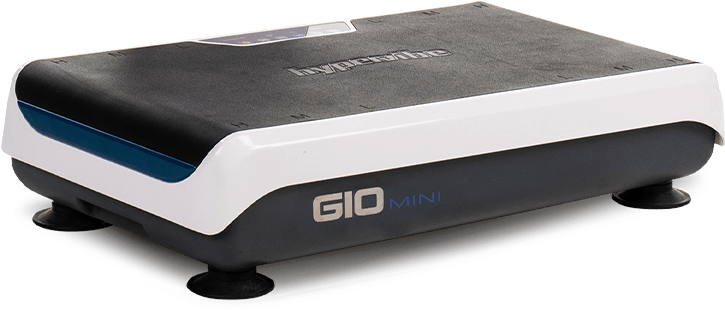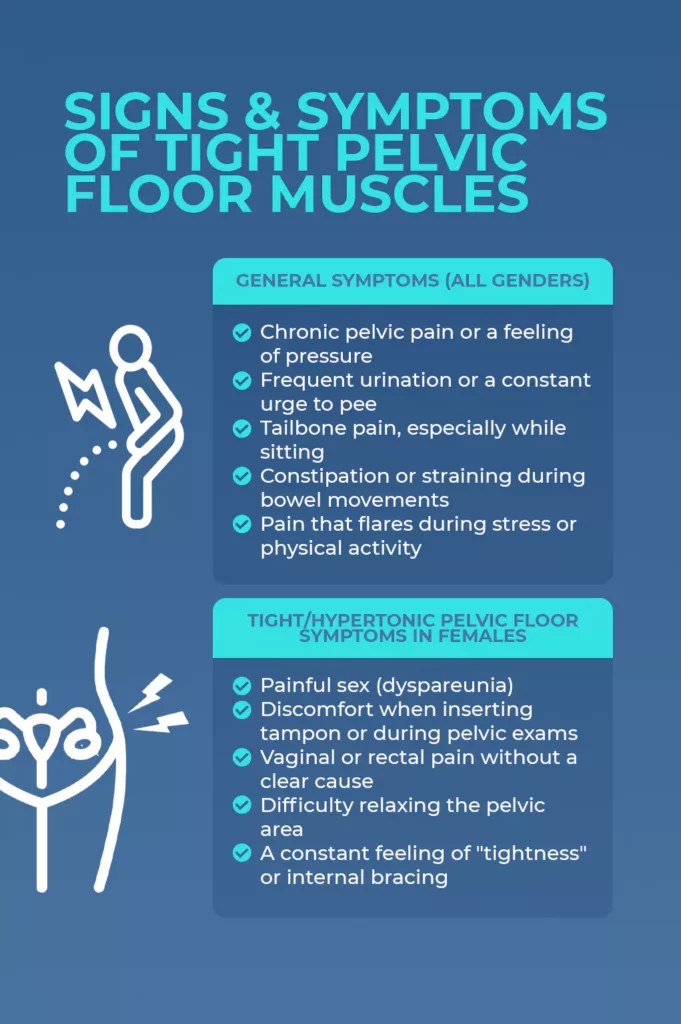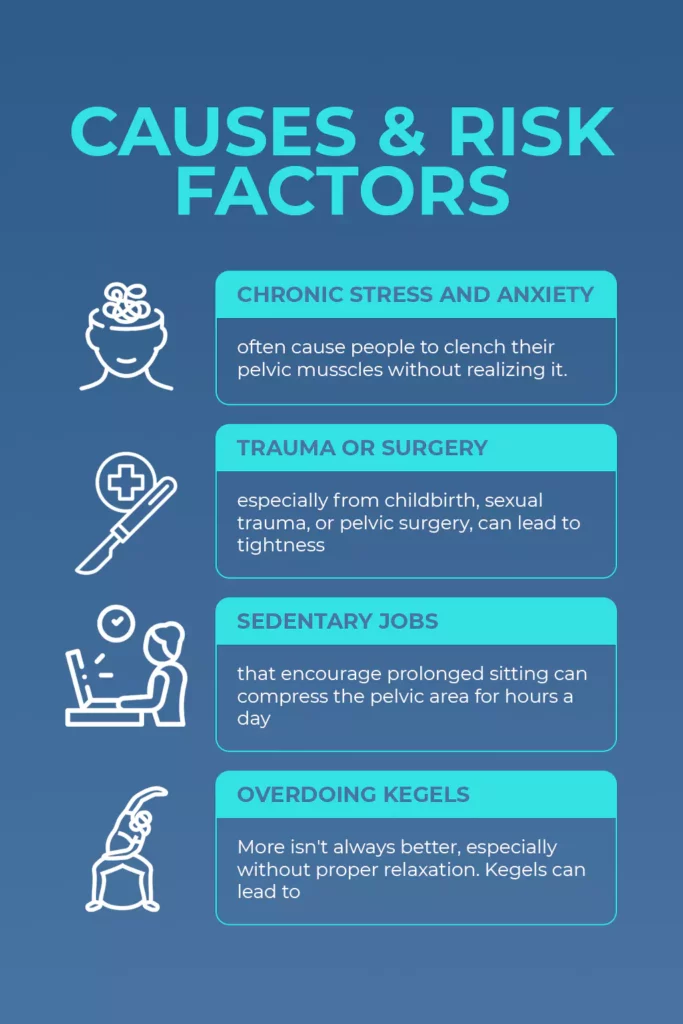
The pelvic floor is a group of muscles and connective tissues that supports the pelvic organs. These organs include the bladder, the rectum (which is part of the large intestine), the uterus, and the vagina, as well as the prostate.
Asymmetrical or tight pelvic floor muscles and connective tissues can lead to pelvic pain and difficult urination, among other issues. It is also known to cause pain with penetration during intercourse for women.
Early attention to the symptoms of pelvic floor dysfunction can prevent chronic issues from developing. These symptoms may point to one common issue called hypertonic pelvic floor dysfunction.
For quick relief when this occurs, try diaphragmatic breathing and gentle external Vibration Therapy (using Whole Body Vibration or WBV technology) to relax the muscles. This should not be confused with internal vibration, such as intravaginal vibratory stimulation, which can directly target and relax pelvic floor muscles as well.





If your pelvic area always feels tense and tight, like it’s gripping or bracing for impact, it might be more than a sign of being stressed out (although that is likely a part of it).
That “clenched fist” sensation deep in the core of your pelvis is a common sign of tight pelvic floor muscles and connective tissue, also called hypertonic pelvic floor dysfunction.
This condition quietly impacts thousands, often leading to symptoms that seem unrelated, such as pelvic pain, urinary urgency, constipation, or pain during intimacy.
The good news is you can retrain your pelvic floor to relax.
This guide breaks down the symptoms of tight pelvic floor muscles, female-specific warning signs, and the most effective treatment strategies, including Vibration Therapy that’s both non-invasive, safe, easy to use, and evidence-backed.
A tight pelvic floor, or hypertonic (“increased tone”) pelvic floor, occurs when the muscles in your pelvic region remain involuntarily contracted and the tissues are overly tight, often due to chronic stress, trauma, or incorrect exercise habits.
Common symptoms of a tight/hypertonic pelvic floor include:
On the other hand, a hypotonic pelvic floor has weak, underactive muscles and tissues that are stretched out struggle to support the bladder and bowel, which causes leakage or prolapse.
Studies show that hypertonic pelvic floor dysfunction is underdiagnosed.
However, it affects many people, especially women.
When tight pelvic floor muscles are treated early, it can prevent chronic issues and restore a better quality of life.
Your pelvic floor isn’t just a group of random muscles and tissues; it’s like a coordinated support sling that holds up everything from your bladder and bowel to (in women) your uterus.
These muscles kick in when you laugh, cough, or lift heavy things, helping prevent leaks.
They also relax when it’s time to pee, poop, or have sex.
But when those muscles get stuck in “clench mode,” the relaxation part doesn’t go as planned.
Everything is under tension.
Instead of releasing, they stay slightly contracted, causing everything from pelvic pain and urinary urgency to constipation and pain during intimacy.
People often confuse pelvic floor strength with tightness, but they’re not the same thing.
A strong pelvic floor means your muscles can contract and relax on demand, with good control, timing, and endurance. They can also generate force when needed.
Here’s what healthy pelvic muscle function should look like:
Pelvic floor strength is often graded on a 0–5 scale by pelvic physical therapists using internal exams, biofeedback, or even ultrasound.
But in hypertonic pelvic floors, strength usually isn’t the issue; it’s that the muscles can’t let go, even if they can squeeze just fine.
The symptoms of a tight pelvic floor can vary from mild discomfort to life-disrupting pain.
Many people don’t realize their symptoms stem from muscle overactivity and tissue tightness..
Here are some key signs to watch for.

Infographic showing signs and symptoms of tight pelvic floor muscles in all genders and females
If these symptoms sound familiar, you’re not alone.
Studies suggest that tight/hypertonic pelvic floor dysfunction affects more women than are currently diagnosed, and many often go untreated for years.
Understanding the causes of tight pelvic floor muscles is the first step toward healing.
A hypertonic pelvic floor usually develops over time because of a combination of physical, emotional, and lifestyle triggers.
These are the most common factors linked to tight pelvic floor muscles:

Infographic listing causes and risk factors of tight pelvic floor muscles with visuals
When you understand these causes of tight pelvic floor muscles, you can find the right treatment approach and prevent recurrence.
Wondering if you might have tight pelvic floor muscles? While only a trained pelvic floor physical therapist can provide a diagnosis, a simple self-check may help you spot red flags.
Stand in front of a mirror with your lower half unclothed.
Gently cough and observe the perineum (area between anus and genitals):
Important to note: Don’t use DIY internal release techniques or devices.
They can worsen symptoms, especially if trauma, endometriosis, or undiagnosed pelvic conditions are involved.
If you suspect you have tight pelvic floor muscles, a licensed pelvic floor physical therapist can assess your condition safely and create a treatment plan for long-term relief.





There’s no one-size-fits-all approach.
However, a combination of professional therapy and at-home strategies tends to work best.
Below is a breakdown to help you understand what each method involves, where it’s done, and how well it works.
|
Method |
How it works |
At‑Home vs Clinical |
|
Pelvic Floor Physical Therapy |
Manual techniques, stretching, and retraining exercises to release tension and improve function. |
Clinical |
|
Biofeedback |
Uses sensors and a monitor to help you learn how to relax your pelvic muscles consciously. |
Clinical |
|
Trigger-Point Release |
Manual or tool-assisted pressure is applied to tight pelvic muscle knots. |
Both |
|
Vibration Therapy/WBV |
Gentle (low g-force) Whole Body Vibration can reduce muscle tone, loosen tight tissue, and improve neuromuscular control. |
Both |
|
Botox Injection |
Temporarily paralyzes overactive pelvic muscles to relieve chronic tightness. |
Clinical |
|
Medication |
Muscle relaxants or pain meds are used to reduce spasms and discomfort. |
Clinical/Prescription |
Most people see the best results from a multimodal approach combining physical therapy, at-home self-care, and guided relaxation techniques.
You are more likely to see results if you combine professional therapy and at-home treatments.
Here are evidence-based treatments you can try:

woman getting professional therapy at a healthcare facility
A certified pelvic health PT can manually release muscle tension, teach correct breathing and posture, and develop a customized recovery plan.
They can also oversee use of Pelvic Floor-related therapeutic technologies.
Whole Body Vibration (WBV) and handheld perineal vibration tools both use low-frequency waves (30–35 Hz) to:
Studies show Vibration Therapy can significantly help those with tight pelvic floors.
For a full guide on Vibration Platforms, read The Ultimate 2025 Vibration Plate Guide.
Focus on gently releasing the pelvic muscles instead of contracting them.
It’s like the opposite of a Kegel and is important for hypertonic cases.
Lie on your back, inhale deeply, and imagine the pelvic floor “melting” downward.
This mental and physical exercise helps to retrain your pelvic muscles to relax.
When you soak in Epsom salts for 15–20 minutes,
you relax the nervous system and support muscle release everywhere.
“Fight or flight” can keep the pelvic floor stuck in tension mode.
Daily breathwork, mindfulness, or journaling can help switch the nervous system into “rest and digest” mode.
Vibration Therapy for the Pelvic Floor
Whole Body Vibration (WBV) is becoming an effective treatment for tight pelvic floor muscles,
especially for those dealing with chronic tension, pain, and muscle guarding.
Vibration Therapy promotes relaxation and vibratory analgesia.
Vibratory analgesia is a neurological effect where vibrations reduce pain signals and encourage the pelvic muscles to release and move.
When you have hypertonic pelvic floors, this can help “reset” the muscle’s baseline tension without invasive procedures.





Recent studies show that WBV can improve pelvic floor muscle (PFM).
It helps with activation and relaxation.
This encourages patients to gain better voluntary control and reduce involuntary spasms.
While more research is ongoing, Vibration Therapy offers a gentle, evidence-informed path to relief for those who need tight pelvic floor muscle treatment options.
This works best when used alongside pelvic floor physical therapy.
You might experience pelvic pain, constipation, painful urination, lower back discomfort, and a constant feeling of tension or pressure in the pelvic region.
Female patients report pain during intercourse, tampon discomfort, or trouble relaxing during pelvic exams.
If these sound familiar, it’s time to consult a pelvic floor specialist.
Yes.
Overactive or clenched pelvic muscles can irritate the bladder and cause you to feel the urge to urinate more frequently, even when the bladder isn’t full.
Yes,
when used correctly.
Vibration Therapy for pelvic floor conditions promotes muscle relaxation through relaxation and vibratory analgesia (override of pain signals).
Both whole-body vibration (WBV) and handheld perineal vibration can reduce muscle guarding, lower tone, ease pain, and improve control.
It works best when paired with professional tight pelvic floor muscle treatment like physical therapy.
For most people, combining at-home care with clinical support yields noticeable improvements within 4–6 weeks.
However, the type of treatment, consistency, and the degree of muscular stiffness all affect how quickly you get results.
It could take a few physical therapy or vibration treatment sessions for some people to feel better, while it might take weeks for others.
Tight pelvic floor muscles can subtly undermine your confidence, comfort, and ability to concentrate. However, if detected early, they can be treated.
You can restore comfort and function by paying attention to your body, consulting a pelvic floor specialist, and utilizing techniques like Vibration Treatment. Don’t endure misery in silence.
Would you like to see how gentle Whole Body Vibration can support pelvic relaxation and healing?
Explore our expert-curated Hypervibe Buyer’s Guide to learn what to look for in a Vibration Platform, how it works, and how to match the right model to your wellness goals.

Here’s how we use a vibration plate for weight loss...

Many people, especially beginners, notice an itchy or tingling “pins-and-needles”...

Taking into consideration the growing popularity of the vibration plate,...

The lymphatic system, also called the lymphoid system, is an...

Are vibration machines bad for you? Yes, if used incorrectly....